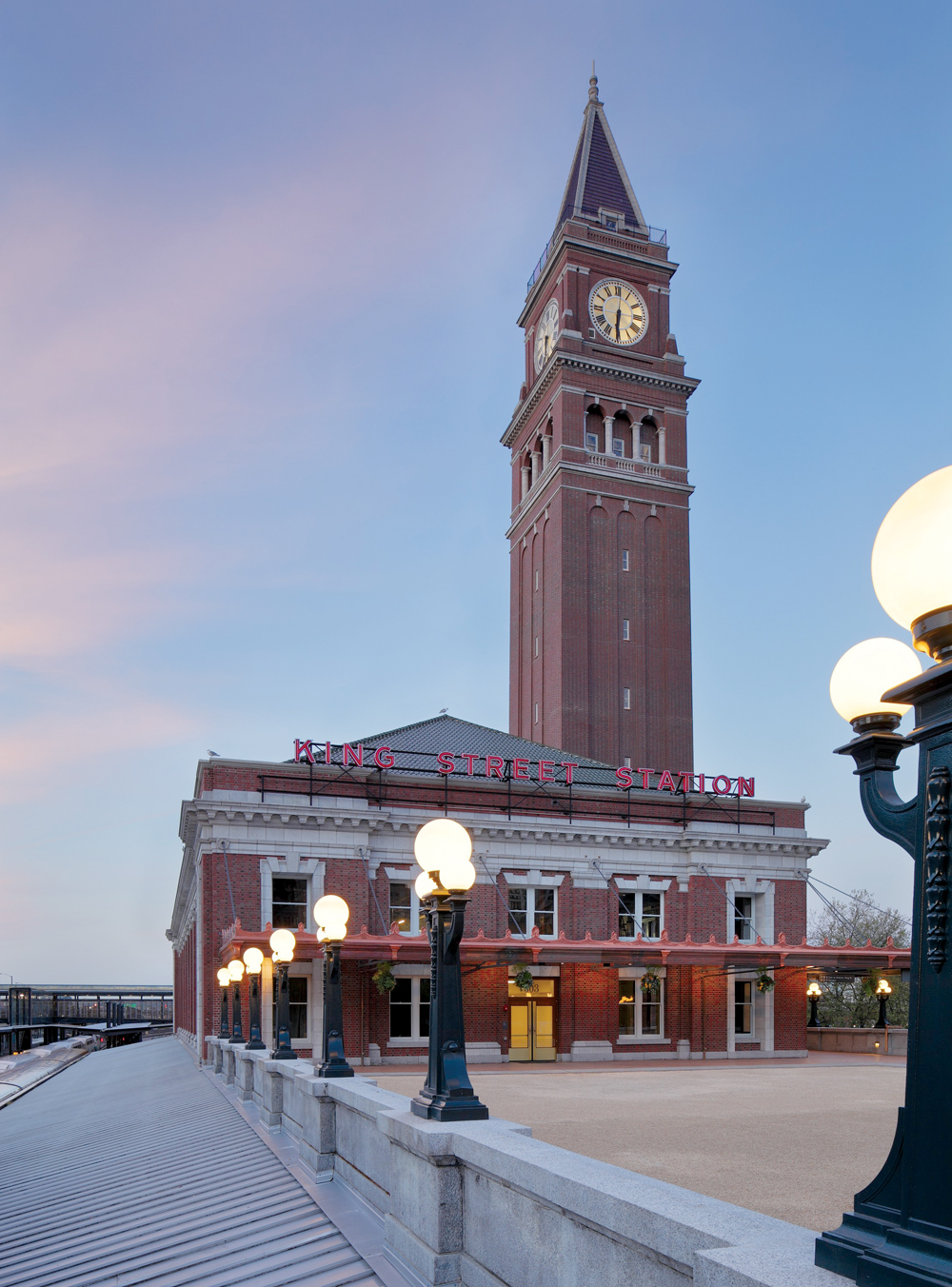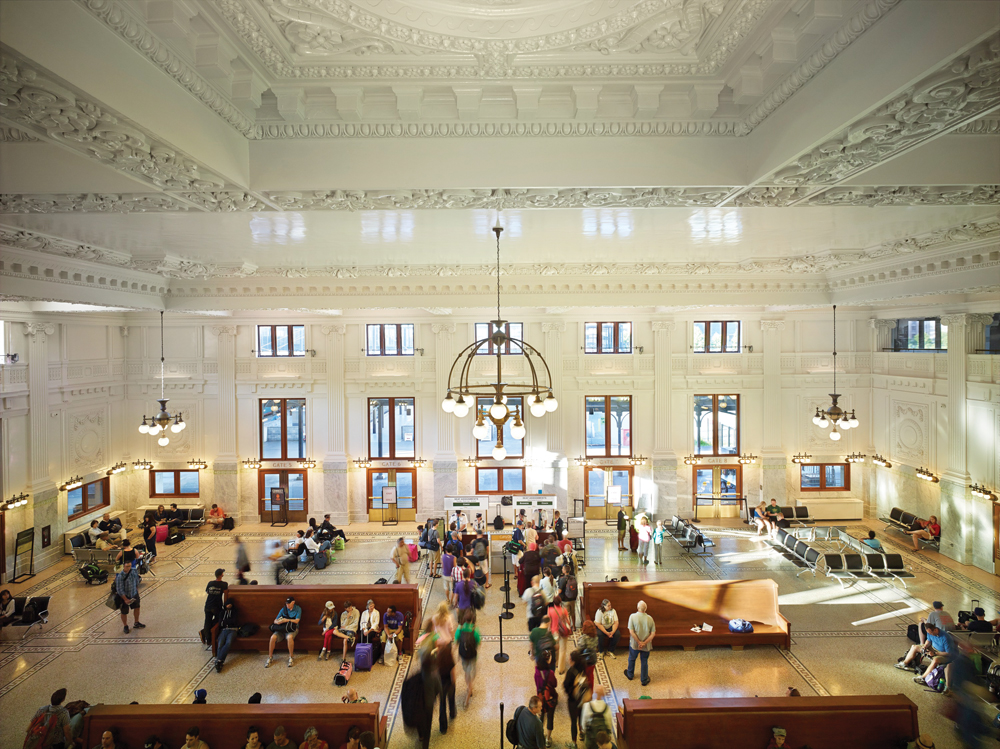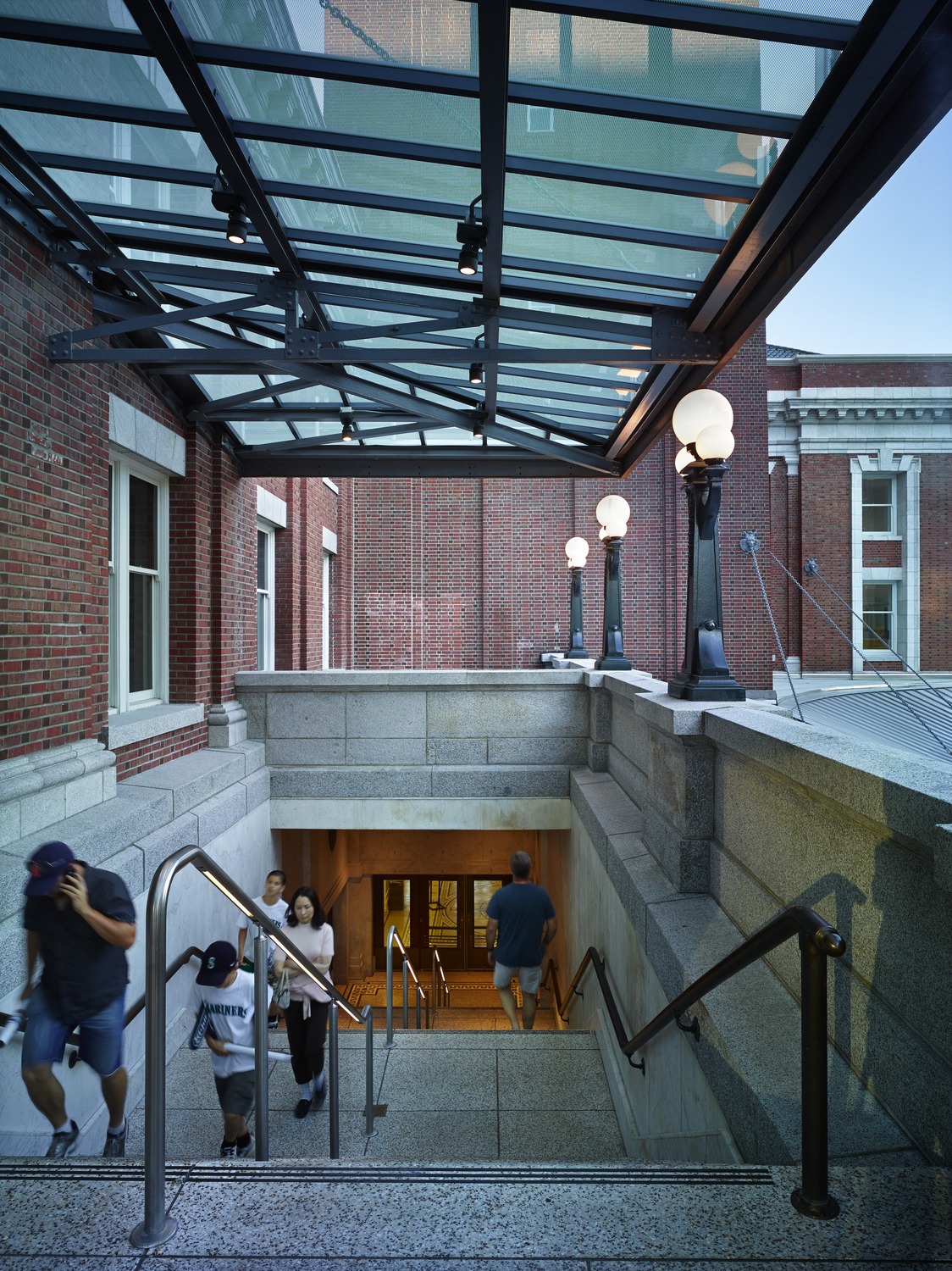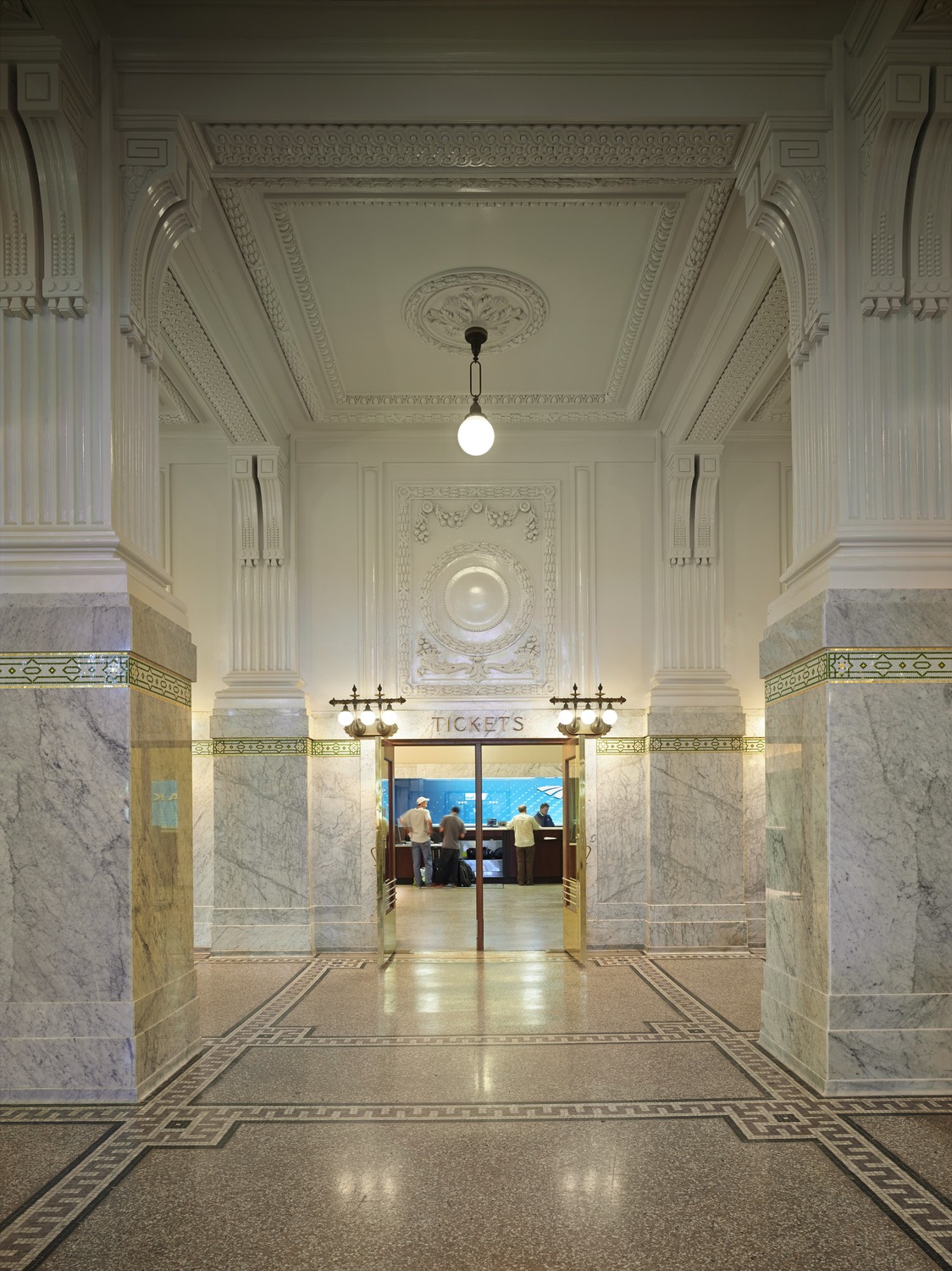When Seattle’s King Street Station opened its doors in 1906, it stood as a bold symbol of the city’s newfound prominence as the region’s primary shipping port—a position the Emerald City holds to this day.
Designed by architects Charles A. Reed (1858-1911) and Allen H. Stem (1856-1931), most noted for their work on New York’s Grand Central Terminal, King Street Station was the centerpiece of a massive enterprise that shifted the city’s main rail lines from the waterfront to the central business district, thanks to the construction of a 5,245-foot tunnel beneath the city. The L-shaped, 62,400-sf terminus quickly became the busiest train station in the Northwest, earning it the nickname “Gateway to the West.”
The Italianate depot features a distinctive, 242-foot-tall clock tower, the second-tallest such structure on the West Coast; it was modeled after the Campanile di San Marco in Venice. At the time of its completion, the station was the tallest structure in Seattle. Inside, bright-white plaster and marble decorated the walls and ceiling of the waiting areas.
The depot was placed on the National Register of Historic Places in 1973, but by that time it had lost much of its grandeur. Poorly conceived modernizations in the ’40s, ’50s, and ’60s led to the removal of large sections of the plaster and marble walls and glass mosaic tile accents. The magnificent plaster ceiling was covered with acoustical tiles. The roof was crumbling. The staircase on Jackson Street was boarded up. The four tower clocks were right only twice a day.
PLATINUM AWARD WINNER
King Street Station
SeattleBuilding Team
Submitting firm: ZGF Architects (architect)
Owner: Seattle Department of Transportation
Structural/MEP engineer: Arup
Construction manager: Shiels Obletz Johnsen
General contractor: Sellen ConstructionGeneral Information
Construction time: Sept. 2009 to April 2013
Size: 62,400 sf
Delivery method: CM at risk
Cost: $55 million
The demise of train travel in the mid-20th century, coupled with a falloff in funding for maintenance, saw the station fall even further into a state of disrepair. Most urgently in need of shoring up were the unreinforced masonry walls—inspections showed that the structure was in no shape to withstand a major seismic event.
As rail ridership began to pick up in the 2000s, the city of Seattle decided it was time to upgrade and restore its landmark rail station. In February 2008, the city purchased the building from the Burlington Northern Railway Company for $10 and then went about rounding up the $55 million needed for a complete rehab and modernization (60% of funding came from federal sources; the balance was split between state and local sources).
The project scope encompassed full seismic retrofit and structural upgrade work, rehabilitation of the clock tower, full MEP/FP upgrades, and repair and restoration of the 45-foot-high ornamental plaster ceilings and walls, the terrazzo and mosaic tile floors, and the operable windows—all while striving for LEED Platinum certification. Complicating matters was a requirement from the city that the station remain fully operational during the project—a goal the team achieved by dividing the work into multiple phases.
INSERTING A NEW STRUCTURE
Half the budget was allocated for the structural repair and seismic retrofit work—a tedious, meticulous process that involved inserting a new steel frame structure inside the existing masonry walls with surgical precision so as not to disturb the historical elements. The Building Team cut 35-foot-high slots into the brick perimeter and inserted steel columns and high-strength grout alongside the existing columns.
New shear walls were created for the 8,000-sf waiting room. Steel floor plates were added on levels two and three for additional strengthening. The 12-story clock tower was cross-braced; new columns were added on all four corners. A total 1,345 tons of steel was installed to support the interior spaces.

A system of geothermal wells was bored underneath the downtown plaza; it is designed to cover 100% of the 62,400-sf building’s heating and cooling needs. The clock tower rises 242 feet to its peak. ZGF Architects led the Building Team for the client, the Seattle Department of Transportation. Photo: Benjamin Benschneider Photography
While not as costly as the structural work, the rehabilitation of the historic interior elements was no less difficult. To replicate damaged and missing elements of the ornamental plaster walls and ceiling, matching molds were painstakingly created using the original ornate pieces and the same casting methods craftsmen employed more than a century ago. The molds were filled with casting plaster and inlaid with hemp and burlap during the casting process to create the final pieces. The castings were then stripped out of the molds, reinstalled, and attached to the structure.
The Building Team removed all of the sashes and trims from the original windows and refinished and reinstalled them using all remaining original glass. In all, the team restored 74 window openings and 199 sashes and replicated 15 window openings and 33 new sashes.
Significant care was taken to protect the floors during the structural steel installation and helical pile drilling. Areas of the marble inlaid terrazzo floors were catalogued, removed, and reinstalled after the new buried structure was installed. Where the original tile flooring was missing, the team repurposed existing pieces of marble to replicate the floor elements.
In honoring King Street Station with a Platinum Award, the Reconstruction Awards jury commended the Building Team on its technical precision in executing both heavy construction work—structural steel reinforcing and geothermal installation—and extremely delicate and often tedious historic restoration work—all while the station remained operational.
“The fact that they were able to execute all of this work while achieving LEED Platinum certification through features like geothermal makes the project even more impressive,” said judge Krista Gnatt, LEED AP, Preconstruction and Business Development Manager with Bulley & Andrews, Chicago.
Related Stories
Urban Planning | Apr 12, 2024
Popular Denver e-bike voucher program aids carbon reduction goals
Denver’s e-bike voucher program that helps citizens pay for e-bikes, a component of the city’s carbon reduction plan, has proven extremely popular with residents. Earlier this year, Denver’s effort to get residents to swap some motor vehicle trips for bike trips ran out of vouchers in less than 10 minutes after the program opened to online applications.
Laboratories | Apr 12, 2024
Life science construction completions will peak this year, then drop off substantially
There will be a record amount of construction completions in the U.S. life science market in 2024, followed by a dramatic drop in 2025, according to CBRE. In 2024, 21.3 million sf of life science space will be completed in the 13 largest U.S. markets. That’s up from 13.9 million sf last year and 5.6 million sf in 2022.
Multifamily Housing | Apr 12, 2024
Habitat starts leasing Cassidy on Canal, a new luxury rental high-rise in Chicago
New 33-story Class A rental tower, designed by SCB, will offer 343 rental units.
Student Housing | Apr 12, 2024
Construction begins on Auburn University’s new first-year residence hall
The new first-year residence hall along Auburn University's Haley Concourse.
K-12 Schools | Apr 11, 2024
Eric Dinges named CEO of PBK
Eric Dinges named CEO of PBK Architects, Houston.
Construction Costs | Apr 11, 2024
Construction materials prices increase 0.4% in March 2024
Construction input prices increased 0.4% in March compared to the previous month, according to an Associated Builders and Contractors analysis of the U.S. Bureau of Labor Statistics’ Producer Price Index data released today. Nonresidential construction input prices also increased 0.4% for the month.
Healthcare Facilities | Apr 11, 2024
The just cause in behavioral health design: Make it right
NAC Architecture shares strategies for approaching behavioral health design collaboratively and thoughtfully, rather than simply applying a set of blanket rules.
K-12 Schools | Apr 10, 2024
A San Antonio school will provide early childhood education to a traditionally under-resourced region
In San Antonio, Pre-K 4 SA, which provides preschool for 3- and 4-year-olds, and HOLT Group, which owns industrial and other companies, recently broke ground on an early childhood education: the South Education Center.
University Buildings | Apr 10, 2024
Columbia University to begin construction on New York City’s first all-electric academic research building
Columbia University will soon begin construction on New York City’s first all-electric academic research building. Designed by Kohn Pedersen Fox (KPF), the 80,700-sf building for the university’s Vagelos College of Physicians and Surgeons will provide eight floors of biomedical research and lab facilities as well as symposium and community engagement spaces.
K-12 Schools | Apr 10, 2024
Surprise, surprise: Students excel in modernized K-12 school buildings
Too many of the nation’s school districts are having to make it work with less-than-ideal educational facilities. But at what cost to student performance and staff satisfaction?




















